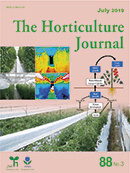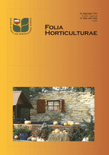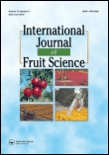
Journal of Berry Research
Scope & Guideline
Nurturing a Community of Berry Scholars
Introduction
Aims and Scopes
- Biodiversity and Genetic Research:
Investigates the genetic diversity and molecular markers of various berry species to enhance breeding programs and improve fruit quality. - Biochemical and Nutritional Analysis:
Explores the biochemical composition of berries, including their polyphenols, vitamins, and antioxidant properties, and their implications for human health. - Cultivation Techniques and Crop Management:
Focuses on innovative agricultural practices, including irrigation, fertilization, and pest management, to optimize berry yield and quality. - Health Benefits and Functional Foods:
Examines the health-promoting properties of berries, including their potential anti-cancer, anti-inflammatory, and antioxidant effects. - Postharvest Physiology and Processing:
Studies the postharvest handling of berries, including storage, processing techniques, and their impact on fruit quality and shelf life. - Environmental and Ecological Impact:
Investigates the effects of climate change and environmental factors on berry cultivation and the ecological niches of berry species.
Trending and Emerging
- Climate Resilience and Adaptation:
Research exploring the impact of climate change on berry species and the development of resilient cultivation practices is increasingly prominent. - Functional Foods and Nutraceuticals:
There is a rising interest in the health benefits of berries, particularly their role as functional foods that can prevent disease and promote wellness. - Metabolomics and Phytochemical Profiling:
Advancements in metabolomic technologies are leading to in-depth studies of berry phytochemicals and their biological activities, contributing to a better understanding of their health benefits. - Innovative Agricultural Practices:
The adoption of novel farming techniques, such as vertical farming and precision agriculture, is becoming a major focus to enhance berry production efficiency. - Bioactivity and Health Research:
An increasing number of studies are focusing on the bioactive compounds in berries and their interactions with human health, particularly in relation to chronic diseases.
Declining or Waning
- Traditional Cultivation Practices:
Research on conventional farming methods for berry production is decreasing as interest shifts towards sustainable and innovative agricultural practices. - Basic Taxonomy and Morphological Studies:
Studies focusing solely on the taxonomy and morphological characteristics of berry species are becoming less frequent, as molecular and genetic approaches gain prominence. - Single-species Focus:
The emphasis on research targeting individual berry species is declining, with a growing trend towards comparative studies that include multiple berry types.
Similar Journals

HORTICULTURAL SCIENCE
Elevating Horticultural Practices through Scholarly Insight.HORTICULTURAL SCIENCE is a premier scholarly journal published by the Czech Academy Agricultural Sciences, focusing on the myriad facets of horticulture, including plant breeding, cultivation techniques, and sustainable practices. With a robust Open Access model established since 2002, it aims to disseminate high-quality research to a global audience, fostering collaboration and innovation within the field. Located in the heart of Prague, Czech Republic, the journal boasts an impressive Q2 ranking in Horticulture as reported in 2023, placing it within the top tier of its discipline. Furthermore, it ranks 52nd out of 115 in the scope of Agricultural and Biological Sciences, reflecting its growing influence and reach in horticultural research. The journal is an essential resource for researchers, professionals, and students alike, aiming to advance knowledge and practices in horticulture through original research articles, reviews, and case studies. With its commitment to academic rigor and relevance, HORTICULTURAL SCIENCE stands as a vital contribution to the ongoing discourse in horticultural studies.

Terra Latinoamericana
Transforming Research into Action for Latin America's SoilTerra Latinoamericana is a prominent academic journal published by the Mexican Society of Soil Science, focusing on the essential disciplines of soil science, biochemistry, and ecology. With a dedicated commitment to open access since 2014, this journal provides a platform for researchers and professionals to disseminate and access cutting-edge research aimed at understanding soil interactions, environmental pollution, and ecosystems within Latin America. The journal holds a Q4 ranking in multiple categories, including Ecology and Soil Science, reflecting its growing presence in the academic landscape and its role in fostering scholarly communication within these fields. Though currently positioned in the lower quartiles, Terra Latinoamericana presents a valuable opportunity for emerging scholars and experienced researchers alike to contribute impactful findings and engage with key issues affecting soil health and ecological sustainability in diverse environments. By promoting innovative research and collaborative dialogue, this journal continues to shape the future of soil science and related disciplines, making it an indispensable resource for the scientific community.

Horticulture Journal
Exploring the Science of Plant CultivationThe Horticulture Journal, published by the Japan Society for Horticultural Science, is a leading academic platform dedicated to the advancement of horticultural research and practices. With an ISSN of 2189-0102 and an E-ISSN of 2189-0110, this journal endeavors to publish high-quality research that emphasizes innovative techniques, sustainable practices, and the science of plant cultivation. The journal has been recognized for its impact within the field, currently holding a Q2 ranking in Horticulture and a Q3 ranking in Plant Science as of 2023, indicating its significant contribution to advancing knowledge. With its open-access model, researchers, professionals, and students have the opportunity to engage with the latest findings, thanks to the journal's commitment to widespread dissemination of information. Since its convergence period began in 2015 and continuing through to 2024, the Horticulture Journal remains instrumental in promoting sustainable and beneficial practices in horticulture science globally.

Notulae Botanicae Horti Agrobotanici Cluj-Napoca
Innovating Agronomy for a Greener TomorrowNotulae Botanicae Horti Agrobotanici Cluj-Napoca is a distinguished open-access journal dedicated to the fields of Agronomy, Horticulture, and Plant Science. Published by the University of Agricultural Sciences and Veterinary Medicine Cluj-Napoca, Romania, this journal serves as a vital platform for disseminating cutting-edge research and innovative practices in botany and agricultural sciences. With an Impact Factor that reflects its significant contributions to the field, it has achieved notable rankings, including Q2 in Agronomy and Crop Science and Horticulture, and Q3 in Plant Science as of 2023. The journal has been an open-access publication since 2019, ensuring maximum visibility and accessibility for researchers worldwide. By fostering the exchange of knowledge among scientists, practitioners, and students, Notulae Botanicae plays a crucial role in advancing the understanding and sustainable practices in the horticultural and agricultural sectors. With its continued growth since it converged in 2007, this journal is a vital resource for anyone looking to stay informed on the latest developments in botanical research.

Erwerbs-Obstbau
Pioneering Discoveries in Horticulture.Erwerbs-Obstbau is a pivotal journal dedicated to the field of horticulture, focusing on research concerning the cultivation and production of fruit. Published by Springer in Germany, this journal plays a crucial role in disseminating innovative findings and advancing the knowledge base within the agricultural and biological sciences landscape. With an impact factor that places it in the Q3 category of horticultural journals, it ranks #68 out of 115 in its field according to Scopus, demonstrating its relevance and contribution to ongoing debates and advancements in horticulture practices. Researchers, professionals, and students benefit from the insights and developments shared in its pages, as the journal has been successfully converging data and insights since its inception in 1983, including continuous contributions from 1996 to the present. Although the journal currently does not offer Open Access, its comprehensive articles are invaluable for anyone invested in the science of fruit cultivation and production.

Folia Horticulturae
Exploring the Depths of Horticultural Research.Folia Horticulturae, an esteemed journal in the field of Horticulture, serves as a pivotal platform for the dissemination of innovative research and developments within agricultural and biological sciences. Published by SCIENDO, this open-access journal has been contributing to the global scientific community since 2004, ensuring that key findings are freely accessible to researchers, professionals, and students alike. Based in Poland, the journal boasts an impressive Q2 ranking in Horticulture, indicating its solid impact and significance in the field, with a Scopus rank of #32 out of 115, placing it in the 72nd percentile. With a commitment to fostering scientific discourse, Folia Horticulturae actively encourages contributions that explore various aspects of horticultural science, from crop management to sustainability practices. This initiative not only enhances knowledge but also advances practical applications, making it an invaluable resource for anyone interested in the intricacies of horticulture.

JOURNAL OF THE PROFESSIONAL ASSOCIATION FOR CACTUS DEVELOPMENT
Cultivating Insights for Cactus ConservationJOURNAL OF THE PROFESSIONAL ASSOCIATION FOR CACTUS DEVELOPMENT is an esteemed publication within the fields of Horticulture and Plant Science, managed by the Professional Association for Cactus Development. With its ISSN 1938-663X and E-ISSN 1938-6648, this journal stands as a vital platform for disseminating research and innovative practices concerning the growth, cultivation, and conservation of cacti. Despite being categorized in the Q4 quartile for both Horticulture and Plant Science in 2023, it provides invaluable insights and breakthroughs that are crucial for advancing knowledge and practices in this specialized area of study. The journal, which has been published consistently from 2003 to 2011 and from 2013 to 2024, encourages contributions from researchers, professionals, and students alike, fostering a community dedicated to the sustainable development of cactus species. Although currently not indexed with an impact factor or H-index, its targeted readership can access essential information to enhance both academic and practical applications within the horticultural sciences. For submission guidelines and further details, authors and readers are encouraged to visit the journal's official site.

International Journal of Fruit Science
Shaping the landscape of fruit science through rigorous research.International Journal of Fruit Science, published by TAYLOR & FRANCIS INC, is a preeminent platform for the dissemination of high-quality research in the fields of Agronomy, Horticulture, Ecology, and Plant Science. With an impressive track record since its inception in 2005 and ongoing convergence up to 2024, this journal serves as a vital resource for scholars and industry professionals alike. Renowned for its rigorous peer-review process and comprehensive publication of cutting-edge studies, it holds a distinguished position in multiple Scopus rankings, including a top 10 placement in Horticulture (Rank #8/115) and notable percentiles, reflecting its significant impact in the academic community. Researchers can delve into critical insights related to fruit cultivation, genetics, and sustainability, bolstered by its Q1 and Q2 quartile standings across various categories. Though the journal is not open access, it remains an essential read for those intent on advancing knowledge and practices within the rapidly evolving landscape of fruit science.

AMERICAN JOURNAL OF POTATO RESEARCH
Leading the Way in Agronomy and Crop ResearchAMERICAN JOURNAL OF POTATO RESEARCH is a prominent scholarly journal dedicated to the field of potato research, encompassing vital areas of Agronomy and Crop Science. Published by SPRINGER, this journal holds an impactful presence in the scientific community, as evidenced by its placement in the Q2 quartile of both Agronomy and Plant Science categories for 2023. With a Scopus rank of #145 out of 406 in Agricultural and Biological Sciences, it offers a significant platform for researchers, professionals, and students alike. Covering diverse topics from cultivation techniques to pest management, the journal aims to advance understanding and innovation in potato science, facilitating the sharing of cutting-edge research and fostering collaboration among scholars. Accessible to a global audience, the journal encourages the dissemination of knowledge through its open-access options. Since its inception in 1998, the AMERICAN JOURNAL OF POTATO RESEARCH has been committed to contributing valuable insights that drive the industry forward and support sustainable agricultural practices.

Scientific Papers-Series B-Horticulture
Connecting Research and Practice in Horticultural Sciences.Scientific Papers-Series B-Horticulture is a distinguished open-access journal published by the University of Agronomic Sciences and Veterinary Medicine Bucharest. With its ISSN 2285-5653 and E-ISSN 2286-1580, this journal has been accessible to the global research community since 2002, ensuring that vital horticultural research reaches a wide audience without barriers. Positioned at the forefront of the horticultural sciences, the journal serves as a platform for original research, reviews, and innovations pertaining to horticultural practices, plant physiology, and sustainable agriculture. Its contributions are not just significant in Romania but also resonate through the international scientific community, helping to address pressing agricultural challenges. The office located at 59 Marasti Boulevard, District 1, Bucharest 011464, Romania, symbolizes its commitment to advancing horticultural knowledge and fostering collaboration among researchers, professionals, and students alike. With no current H-index data, the journal invites continued contributions to enhance its visibility and impact in the field.